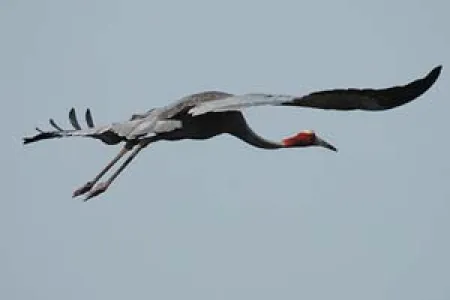Researcher works to secure a future for threatened species
A Charles Darwin University student has been working in Cambodia to study the majestic and globally threatened Sarus Crane to better understand its conservation needs.
Research Institute for Environment and Livelihoods PhD candidate Robert van Zalinge worked in the remote floodplains and wetlands of Tonle Sap floodplain and the Mekong Delta to study the seasonal ecological requirements of the Eastern Sarus Crane.
“This species has been the subject of conservation action for over a decade,” Robert said. “Despite this work, including nest protection and creation of three new protected areas in Cambodia encompassing the most important dry season foraging sites, the population has not increased.”
He said that many of the threats to cranes were due to human impacts such as conversion of natural wetlands for rice farming. Aside from losing their habitat, cranes are often considered a pest as they returned to their traditional feeding grounds in search of food.
“There is still a lot of hunting and capture of young cranes for zoos, to be kept as pets, or simply for food,” he said. “The forests where cranes build their nests are also rapidly declining in extent.”
Robert said the lack of a detailed picture of movements throughout the year further meant scientists did not have the information necessary to conserve the population effectively.
He has been tracking the birds to find out more about their movements.
“Cranes using the Mekong Delta originate in breeding sites in the north and north-east, while all cranes from Ang Trapeang Thmor and Stoung bred in the north,” he said. “The Northern Plains seems to be the most important breeding area for cranes in Cambodia.”
He said results so far indicated that cranes ran into problems in the wet season, particularly the juveniles.
“Juveniles, when abandoned by their parents after approximately nine months of rearing, can differ in habitat preferences from their parents during the breeding season and may make frequent movements.”
He said that, unfortunately, cranes and juveniles often used rice fields, putting them at great risk.
“When they move away from conservation areas, this is definitely one of the major factors leading to mortality of individuals,” he said.
“It is a globally threatened species and the population is vulnerable to collapsing if a special effort by people is not made to ensure they can continue to find a place in human-dominated landscapes.”
The results of his project will feed into an action plan that will be prepared later this year.
Robert’s work is supported by the Wildlife Conservation Society, Wildfowl and Wetlands Trust, Charles Darwin University, the Critical Ecosystem Partnership Fund, the Rufford Foundation and the National Geographic Society
